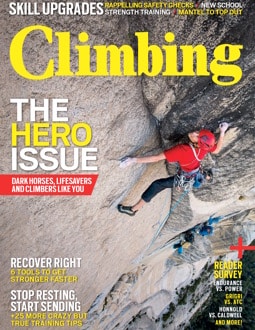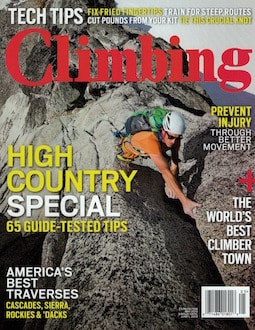Most climbers know better than to just jump on their project cold. A thorough warm-up increases blood flow, muscle flexibility, and body control. A complete warm-up includes four components, all to be performed in the following succession:
- Increase Blood Flow
- Improve Mobility
- Target Stability
- Begin Climbing
View the article below to learn more
Fullscreen ModeKey Points From the Article
Increase Blood Flow
Perform 5–10 minutes of aerobic exercise to elevate your deep-muscle temperature, which makes the muscles more adaptable and less likely to strain or tear. Anything that increases your heart rate—jumping jacks, a brief run, a spin on an exercise bike, etc.—will do. If you’re climbing outside, the approach often fits the bill. How intense should your aerobic exercise be? A simple guideline is once you start sweating, your body is warmed up. If you want to be more scientific, warm up with a target heart rate of 50 percent of your max—subtract your age from 220 and multiply by .5. For example, if you’re 30, your target heart rate would be 95 beats per minute ([220-30] x .5).
Improve Mobility
Dynamic stretching—smoothly moving through a full range of motion, spending equal time in each phase of the stretch—helps improve mobility prior to climbing. You can perform the wrist and finger exercises described here and in the Target Stability section in 6 minutes, alternating in 30-second blocks between the two stretches in each section without resting. However, we each might need to spend more or less time on either Mobility or Stability (see sidebar). If you have stiff muscles and limited flexibility, improve mobility by performing four minutes of mobility stretches and two minutes of stability exercises. If you have loose joints and excessive flexibility, target stability by performing four minutes of stability exercises and two minutes of mobility stretches. If you’re not sure, perform each set of stretches equally—for 3 minutes each.
Target Stability
The forearm and fingers contain two types of major muscle groups: Those on the palm side are flexors, while those on the back are extensors. Climbing overdevelops the flexors, which can lead to overuse injuries and weakness of the extensors, which help to stabilize the wrist and fingers. In a 2015 study by Vigouroux et al., climbers had 37.1 percent greater finger flexor strength than non-climbers, but had similar strength in their finger extensors. Given this imbalance, it’s important that we activate the extensors prior to climbing to balance the loads. To activate a muscle, you need to maintain a sustained pressure against a light resistance. This allows you to develop a brain-body connection to “wake up” the targeted muscle. For the exercises below, you’ll need a resistance band (or a cordelette tied at shoulder width) and a rubber band.
Begin Climbing
After you complete the first three steps of the warm-up and are feeling flexible and strong, begin climbing gradually, with “high volume/low intensity,” and progress into “low volume/high intensity”—this gradual progression lets the muscles, tendons, and nervous system adapt to the progressive demands of climbing harder and generating maximal force. I recommend starting with two to three (high volume) easier climbs that are three numbers below your consistent upper grade (low intensity). For example, if you climb 5.11, warm-up on 5.8s; if you boulder V5, warm-up on V2s. Your on-the-wall warm-up is also a great time to focus on technique. Hone your footwork, limit the tendency to over-grip, and focus on fluid body movement. Slowly begin to decrease the volume to one to two climbs of slightly higher intensity until you’re ready to hop on your project.


